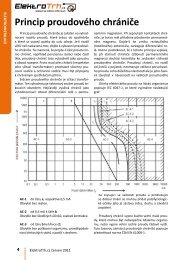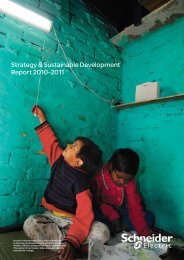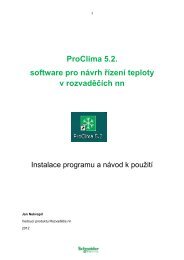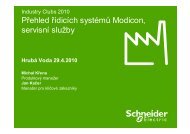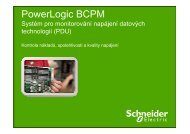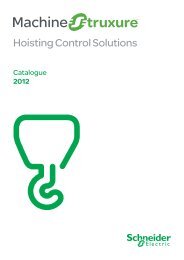2010Annual Report - Schneider Electric CZ, s.r.o.
2010Annual Report - Schneider Electric CZ, s.r.o.
2010Annual Report - Schneider Electric CZ, s.r.o.
Create successful ePaper yourself
Turn your PDF publications into a flip-book with our unique Google optimized e-Paper software.
1.11 - Impairment of assets<br />
In accordance with IAS 36 – Impairment of Assets – the Group<br />
assesses the recoverable amount of its long-lived assets as follows:<br />
• for all property, plant and equipment subject to depreciation and<br />
intangible assets subject to amortisation, the Group carries out a<br />
review at each balance sheet date to assess whether there is any<br />
indication that they may be impaired. Indications of impairment<br />
are identifi ed on the basis of external or internal information. If<br />
such an indication exists, the Group tests the asset for impairment<br />
by comparing its carrying amount to the higher of fair value minus<br />
costs to sell and value in use;<br />
• non-amortisable intangible assets and goodwill are tested for<br />
impairment at least annually and whenever there is an indication<br />
that the asset may be impaired.<br />
Value in use is determined by discounting future cash fl ows that will<br />
be generated by the tested assets, generally over a period of not<br />
more than fi ve years. These future cash fl ows are based on Group<br />
management’s economic assumptions and operating forecasts. The<br />
discount rate corresponds to the Group’s weighted average cost<br />
of capital (WACC) at the measurement date plus a risk premium<br />
depending on the region in question. The WACC stood at 8.4% at<br />
December 31, 2010, a slight increase on the 8.1% at December 31,<br />
2009. This rate is based on (i) a long-term interest rate of 3.8%,<br />
corresponding to the average interest rate for 10 year OAT treasury<br />
bonds over the past few years, (ii) the average premium applied to<br />
fi nancing obtained by the Group in the fourth quarter of 2010, and<br />
(iii) the weighted country risk premium for the Group’s businesses in<br />
the countries in question.<br />
The perpetuity growth rate was 2%, unchanged on the previous<br />
fi nancial year.<br />
Impairment tests are performed at the level of the cash-generating<br />
unit (CGU) to which the asset belongs. A cash-generating unit is the<br />
smallest group of assets that generates cash infl ows that are largely<br />
independent of the cash fl ows from other assets or groups of assets.<br />
The cash-generating units correspond to the Power, Industry, IT,<br />
Buildings, CST businesses, which have operated as divisions since<br />
the reorganisation on January 1, 2010. Entities were reallocated to<br />
the new CGUs at the lowest possible level on the basis of their<br />
business activities; in the case of mixed entities, their assets were<br />
allocated to each business (Power and Industry mainly) pro-rata to<br />
their revenue in that business.<br />
At end-2010, the Distribution business acquired from Areva on<br />
June 7, 2010 wasn’t allocated to any specifi c CGU and hadn’t yet<br />
been tested given the recent date of acquisition. Nevertheless, as<br />
2010 results were slightly ahead of the forecasts in the business plan<br />
used for the purposes of the acquisition, the Group does not feel<br />
there that there are impairment risks with respect to these assets at<br />
the balance sheet date.<br />
The WACC used to determine the value in use of each CGU was<br />
9.0% for Power and Industry, 9.2% for IT, 8.6% for Buildings and<br />
CST.<br />
Goodwill is allocated when initially recognised. The CGU allocation is<br />
done on the same basis as used by Group management to monitor<br />
operations and assess synergies deriving from acquisitions. As a<br />
result of the organisational changes effective January 1, 2010, the<br />
allocation of goodwill has been changed to refl ect the new operating<br />
segments defi ned in accordance with the newly issued IFRS 8. This<br />
modifi cation did not have an impact on asset impairment.<br />
CONSOLIDATED FINANCIAL STATEMENTS<br />
NOTES TO THE CONSOLIDATED FINANCIAL STATEMENTS<br />
Where the recoverable amount of an asset or CGU is lower than<br />
its book value, an impairment loss is recognised. Where the tested<br />
CGU comprises goodwill, any impairment losses are fi rstly deducted<br />
therefrom.<br />
1.12 - Non-current financial assets<br />
Investments in non-consolidated companies are classified as<br />
available-for-sale fi nancial assets. They are initially recorded their<br />
cost of acquisition and subsequently measured at fair value, when<br />
fair value can be reliably determined.<br />
The fair value of equity instruments quoted in an active market may<br />
be determined reliably and corresponds to the quoted price on the<br />
balance sheet date (Level 1 input as described in the amendment to<br />
IFRS 7 – Improving Disclosures about Financial Instruments).<br />
In cases where fair value cannot be reliably determined (Level 3<br />
inputs), the equity instruments are measured at net cost of any<br />
accumulated impairment losses. The recoverable amount is<br />
determined with reference to the Group’s share in the entity’s net<br />
assets along with its expected future profi tability and outlook. This<br />
rule is applied in particular to unlisted equity instruments.<br />
Changes in fair value are accumulated in equity under “Other<br />
reserves” up to the date of sale, at which time they are recognised<br />
in the income statement. Unrealised losses on assets that are<br />
considered to be permanently impaired are recorded under “Finance<br />
costs and other fi nancial income and expense, net”.<br />
Loans, recorded under “Other non-current fi nancial assets”, are<br />
carried at amortised cost and tested for impairment where there<br />
is an indication that they may have been impaired. Long-term<br />
fi nancial receivables are discounted when the impact of discounting<br />
is considered signifi cant.<br />
1.13 - Inventories and work in process<br />
Inventories and work in process are stated at the lower of their entry<br />
cost (acquisition cost or production cost generally determined by the<br />
weighted average price method) or of their estimated net realisable<br />
value.<br />
Net realisable value corresponds to the estimated selling price net of<br />
remaining expenses to complete and/or sell the products.<br />
Inventory impairment losses are recognised in “Cost of sales” for<br />
the material component and in “Selling, general and administrative<br />
expenses” for the fi nished products.<br />
The cost of work in process, semi-fi nished and fi nished products,<br />
includes the cost of materials and direct labor, subcontracting costs,<br />
all production overheads based on normal capacity utilisation rates<br />
and the portion of research and development costs related to the<br />
production process (corresponding to the amortisation of capitalised<br />
projects in production and product and range maintenance costs).<br />
2010 REGISTRATION DOCUMENT SCHNEIDER ELECTRIC 163<br />
5




